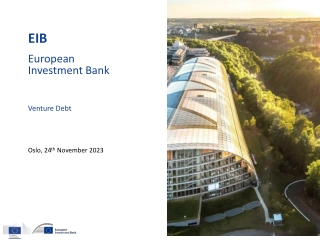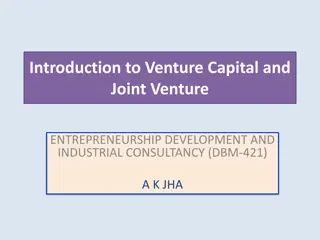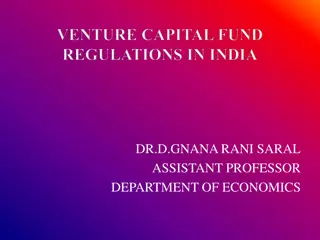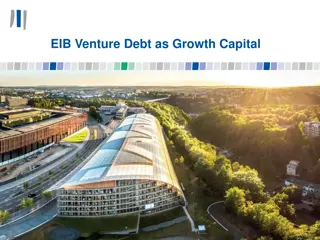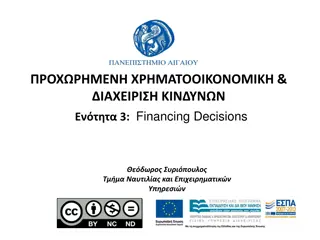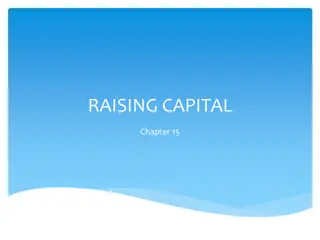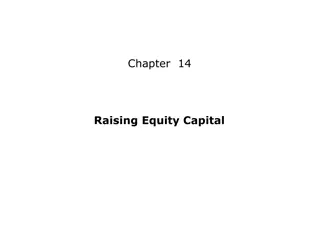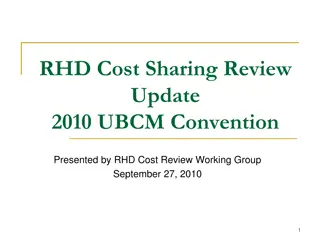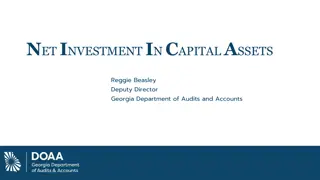Government Venture Capital Programs: Enhancing Innovation Through Public Funding
Government Venture Capital (GVC) programs aim to bridge the equity gap for innovative young firms by providing funding and support. While GVCs can yield social payoffs, concerns exist about their effectiveness and potential to crowd out private investments. Direct public intervention in GVC funding allocation varies, offering potential benefits and challenges.
Download Presentation

Please find below an Image/Link to download the presentation.
The content on the website is provided AS IS for your information and personal use only. It may not be sold, licensed, or shared on other websites without obtaining consent from the author.If you encounter any issues during the download, it is possible that the publisher has removed the file from their server.
You are allowed to download the files provided on this website for personal or commercial use, subject to the condition that they are used lawfully. All files are the property of their respective owners.
The content on the website is provided AS IS for your information and personal use only. It may not be sold, licensed, or shared on other websites without obtaining consent from the author.
E N D
Presentation Transcript
VCs provide portfolio companies with bundles of value-added activities, including direct coaching and indirect benefits, such as a certification effect to third parties (e.g. customers, skilled workers, alliance partners, and financial intermediaries). Innovative young firms play a key role in modern knowledge-based economies Unfortunately, these firms suffer from financing constraints, which limit their growth and menace their survival. However, the equity gap faced by young innovative firms cannot be entirely solved by the private VC market. In response, many governments have set up programs to foster VC financing, through the establishment of GVC funds.
GVC advantages vs negative effects Besides addressing the financial gap problem, GVCs can pursue investments that will ultimately yield social payoffs and positive externalities for society as a whole. The recent financial crisis has increased the difficulty for these firms to raise seed and early-stage finance, as VCs have become more risk adverse and have focused on later-stage investments. As a consequence, policy interventions have increased in recent years in many OECD countries The drawback of these instruments, however, is that they may crowd out rather than stimulate private investments. The rationale and appropriateness of these programs are at the center of a controversial academic debate.
GVC - Social payoffs The selective provision of GVC funds to underfunded young innovative firms can signal their high potential to private sector investors and, thus, foster the additional funding of these firms. Thanks to signaling effects, GVCs can have a positive, crowding-in effect on the development of VC markets. As GVC is generally instrumental to broader policy objectives, the activity of GVC programs is not guided exclusively by the financial goals that are (allegedly) typical of private sector investors. Accordingly, GVCs will consider investments that might not be as satisfactory in terms of return for risk, if the investment could generate significant social payoffs or localized public benefits (e.g. job creation or economic growth in a specific region or sector).
Main concerns about GVC First, there is skepticism regarding the ability of GVC investors to pick winners, because investors might lack the skills to perform successful selections or because of possible distortions of the investment strategies due to political interests (Brander et al. 2008). Second, GVC programs might not be effective in monitoring, nurturing, and mentoring investee companies Third, and most importantly, public investment may displace private investment, leading to crowding-out effects. As GVC investors have broader objectives than independent VCs, they are less accountable for generating high returns. Therefore, the provision of cheap equity capital by GVC investors discourages private investors, leading to replacement, rather than engagement, of private VCs
Direct Public Intervention With regard to direct public intervention, there is heterogeneity in the type of allocation of governmental funds to GVCs. Allocation types can be classified into three categories: 1. direct public funds, 2. hybrid private public funds, 3. and funds-of-funds.
Direct PF Direct public funds include investments through government- supported VC-like schemes, often with the aim of facilitating the development of a VC industry within a region or industry. For example, In-Q-Tel was founded by the US Federal Intelligence Community in 1999 to finance information technologies. OnPoint Technologies was founded by the US Army in 2002 to finance investments for new power and energy solutions.
Hybrid approach Due to problems related to a lack of skills or crowding-out issues, some of direct funds have been modified to include co-investments from private investors. The German High-Tech Grunderfonds fund, whose investors include the German Federal Ministry of Economics and Technology, the KfW Banking Group, and 12 industrial groups, is an example of a hybrid VC fund. From a critical perspective, these public private partnerships could be viewed as subsidies to large firms
Funding funds Lastly, government support can take the form of funds-of-funds, which invest in other investment funds rather than investing directly in companies. On January 21, 2014, the Canadian Finance Minister announced the establishment of the Northleaf Venture Catalyst Fund, the first fund- of-funds established under Canada s Venture Capital Action Plan. Of the CAN$ 217.5 million in this fund, CAN$ 145 million are from institutional and corporate investors, while the governments of Canada and Ontario each provide CAN$ 36.3 million.
Crowding-in First, these programs typically seek a crowding-in effect on private VCs. For instance, the Australian Innovation Investment Fund (IIF) aims to develop a self-sustaining Australian early stage, technology-based venture capital industry In Israel, the Yozma Group was launched in 1993 using public funds. Yozma is widely considered to be the catalyst for the successful development of the domestic VC industry in that country. As the domestic VC industry matured, the role of the government declined, and Yozma was privatized and sold.
failures In contrast, Armour and Cumming (2006) find no support for the crowding-in effect in a sample of 15 Western European and North American countries. Bertoni et al. (2014) show that although European governments have tried to fill the seed investment gap left by private VC investors, by launching GVC funds (e.g. university seed and regional government- controlled funds) and investing in small, young, seed-stage companies, notably biotech firms, they have failed to attract private VCs to these companies.
Evaluating GVC performance A growing literature has examined the treatment effect (Bertoni et al. 2011, 2013) of GVC investments in portfolio firms ..by considering different performance measures: successful exit (time and returns), innovation (e.g. commercialization of R&D activities) growth (e.g. growth rate of sales) coaching and the value added by GVC investors to portfolio firms.
Black and white.. Global empirical evidence is mixed; good examples, such as the Australian IIF, are in contrast with a lack of success of GVC programs in other countries. Consequently, the design of proper investment processes of GVCs is an urgent item in the agenda of scholars and policy makers.
Open issues There remain some open research questions. First, the treatment effects of GVC investors on portfolio firms require further analysis regarding the role of moderating factors, including firm-level factors, such as the age, size, human capital endowment, and business model of the firm; investor-level factors, such as the experience and centrality of the GVC investor; and institutional-level factors, such as the complementarity between GVC and other policy measures supporting young innovative firms Social pay-off and development impacts and its actual value
extent of regulation of financial markets, particularly with regard to accessing public equity. Restricting laws aimed at restoring investor protection, such as the 2002 Sarbanes Oxley (SOX) Act in the USA, have had unintended, overreaching consequences; new ways to finance entrepreneurial ventures may emerge at the crossroads between private and public equity - crowdfunding has started making its way into entrepreneurial finance. Equity crowdfunding will allow unsophisticated investors to invest directly in young innovative firms.


